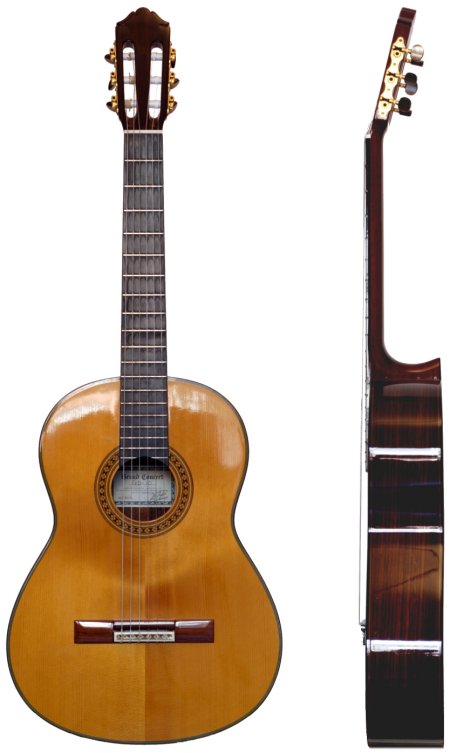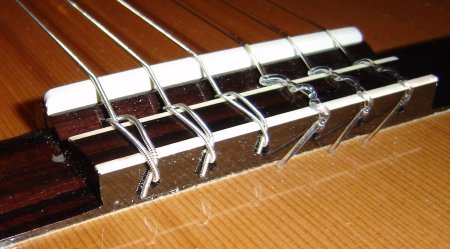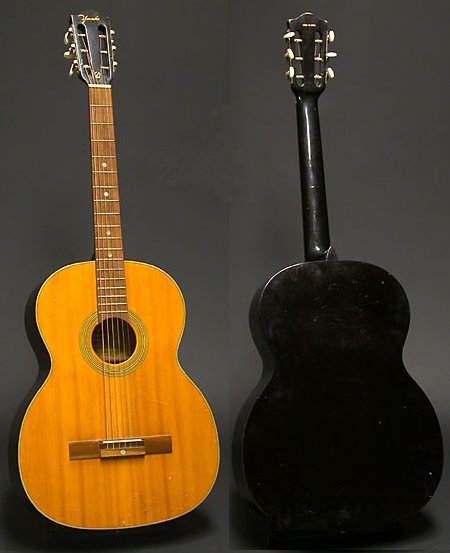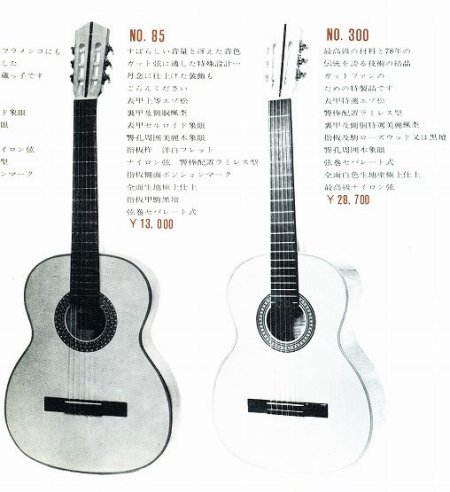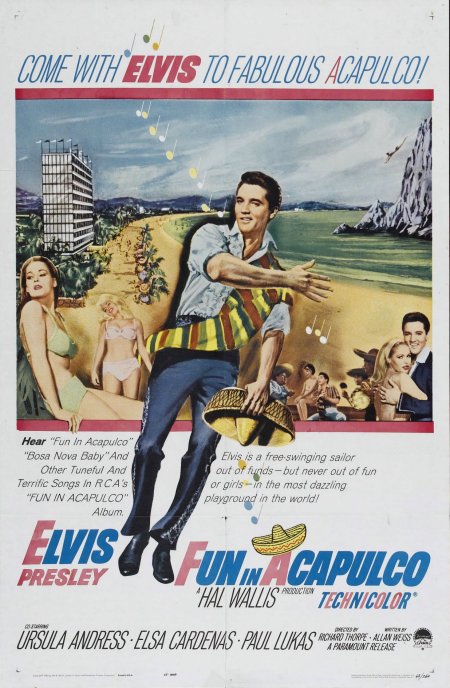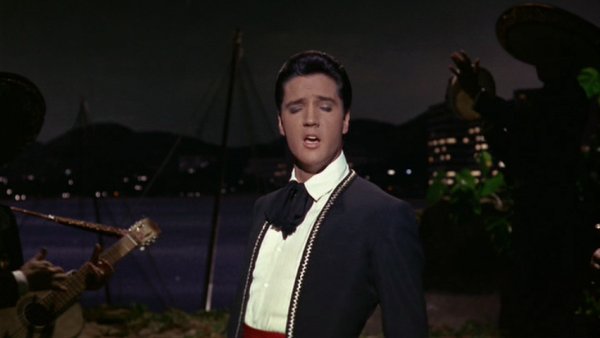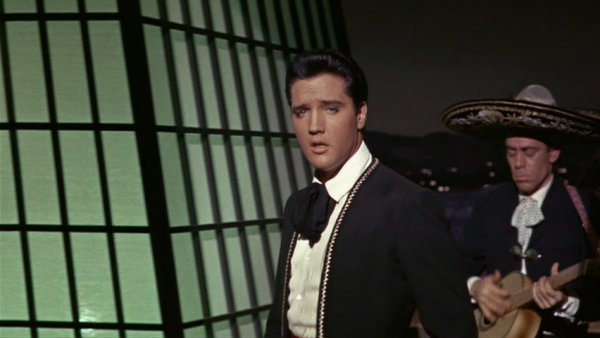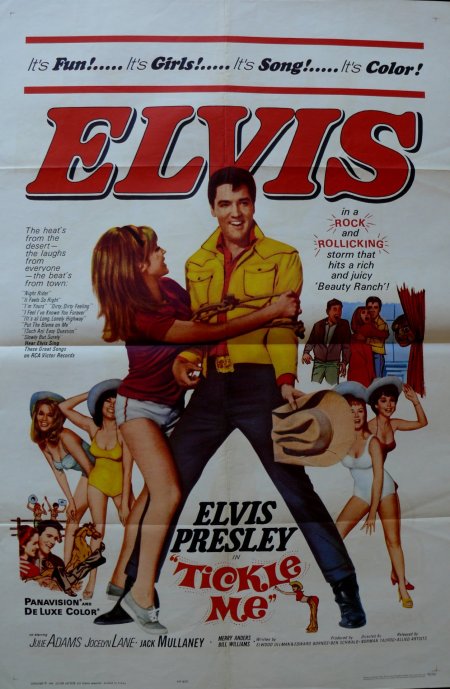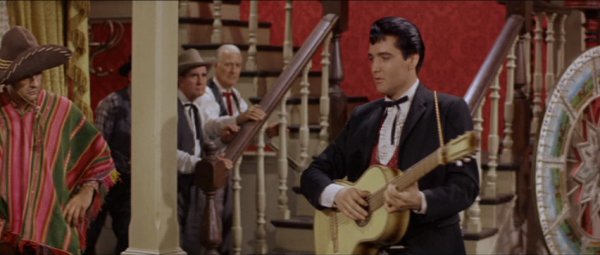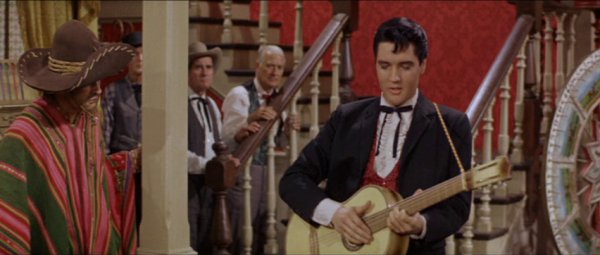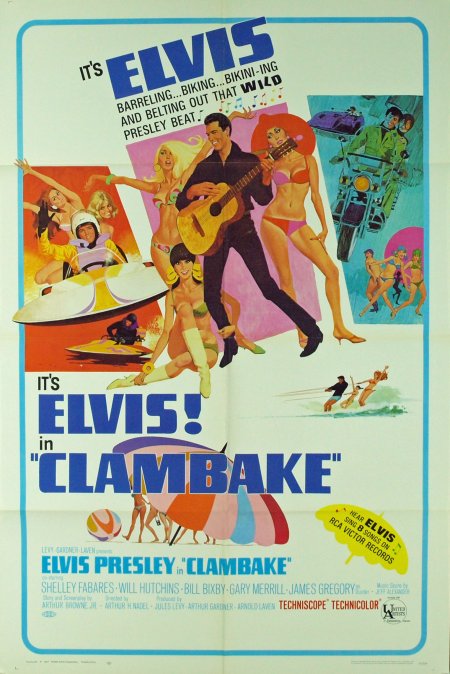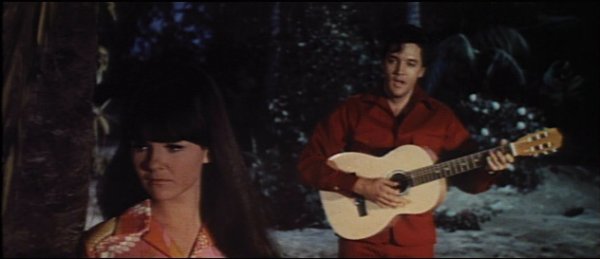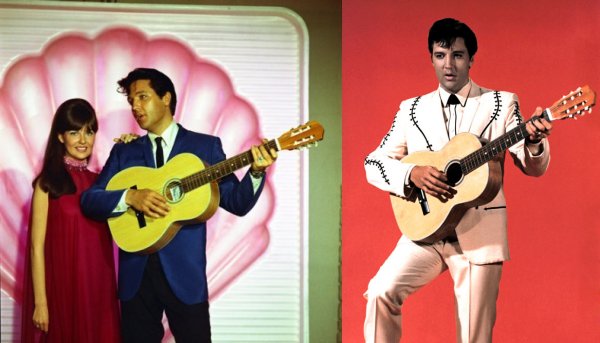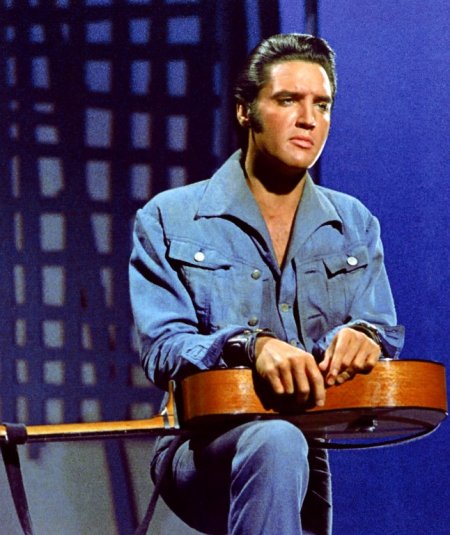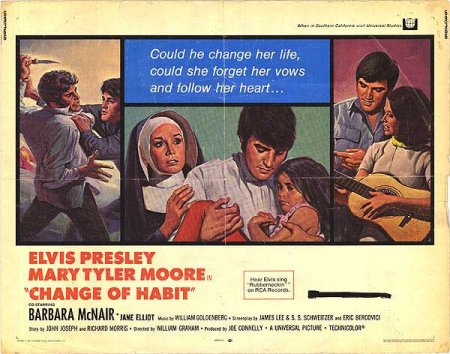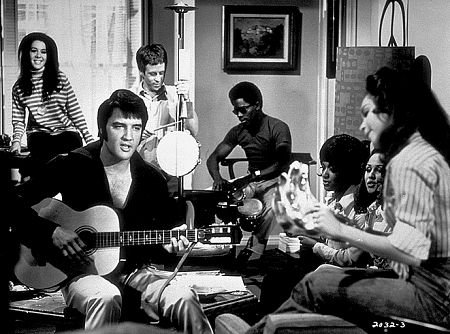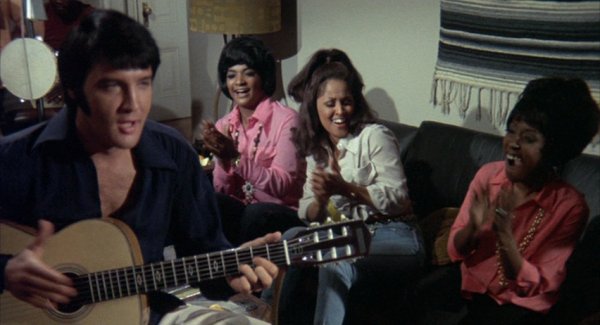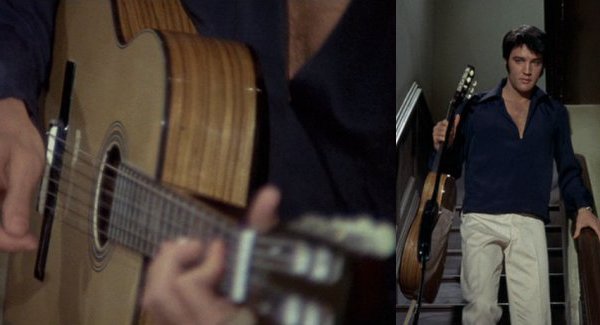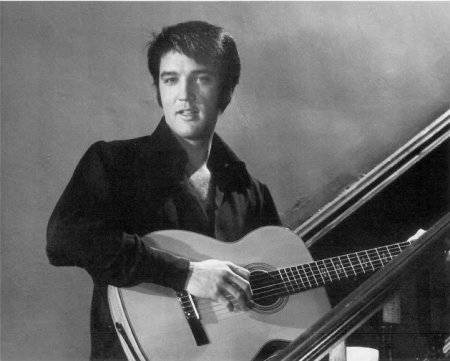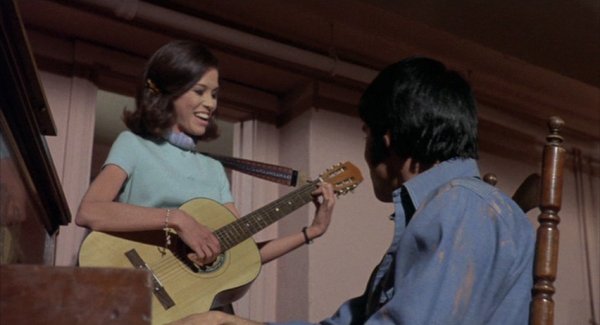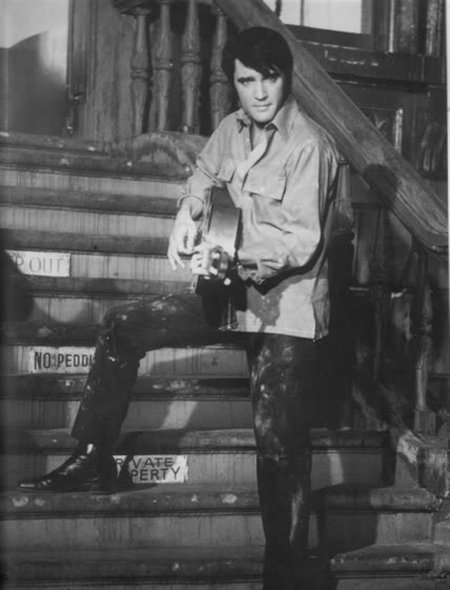 |
Various "Classical" guitars Several guitars used by Elvis in a few of his films are of a fairly common "classical" design revealing little to no manufacture specific distinguishing features. Without a clear shot of a visible brand name or label they are not so easily identifiable. They could have been made by any one of number of companies, foreign or domestic. Some were truly traditional style classical guitars while others were steel string with classical style features.
Classical guitars differ from steel string acoustic guitars in several ways. Probably the most common way in construction, if not visible, is in the neck. On traditional classical guitars, the neck is made in one piece and built into the instrument itself, notched at the heel to receive the sides and glued to both the soundboard and the back. Called the "Spanish heel," this method is lightweight and provides a strong couple between the back and top. On steel string acoustic guitars, the neck is normally built and finished separately from the body of the instrument, then dovetailed or bolted into a neck block glued into the guitar body. The finishes on Martin guitars are applied before assembly while on Gibson guitars the finish is applied after.
Classical guitar were designed for a method of playing that involves intricate finger picking techniques. As such they have a wide, flat fretboard with, normally, no fret markers. The strings, today, are commonly nylon (metal wrapped nylon on the lower three) but traditionally were animal gut. Instead of bridges with pins to anchor the strings, these guitars have tie block bridges. The guitars also traditionally have slotted headstocks. In the 19th century, the standard guitar headstock, or peghead, was either slotted for geared tuners or solid and flat for "friction" pegs made of wood, bone or ivory. Slotted headstocks are also now found on contemporary guitars built to be vintage or traditional in style.
The first guitars made by the Yamaha company of Japan were Classical guitars. The older Yamaha models, like the pre 1965 "Dynamic" series at least, had both slotted headstocks and fret markers on the fretboard at the 5th, 7th, 10th, 12th frets. Other features were eighteen full frets, solid spruce tops on some models and mahogany sides, back, neck, with a rosewood fret board and bridge.
Like the Parlor style steel string acoustic used in Wild in the Country, several of the classical style guitars used by Elvis in his movies, if not recognizable by brand, though they are suggestive as Yamahas, are at least recognizable as either Classical or steel string with traditional features.
The 1963 release of Paramount's Fun In Acapulco was Elvis' thirteenth film and his sixth for Paramount. In the film he is cast as a Circus trapeze artist working in Mexico as a lifeguard/entertainer while he deals with his fear of heights. Production for the film began in January of 1963 and it was released in theaters the following November.
Though Elvis doesn't actually play any of the guitars in this film it features several he used in previous films and one in particular he would use later in another. In a scene set in one of the neighboring nightclubs he is performing in another actor in the band is playing a classical guitar in the traditional sense. The guitar has an Antigua like finish and was later seen used by Elvis in the film Tickle Me.
The 1965 release of Tickle Me was Elvis' eighteenth film and the one and only made for the financially strapped studio, Allied Artists. Shot entirely on the studio back lot and using no new songs at all Elvis, the principal guitar Elvis is seen using in the film is the Gibson J-200 from Paramount. However, in one scene depicting the setting of a saloon in the old west Elvis plays the Antigua finished classical guitar first seen in Fun in Acapulco.
The finish on this guitar is rather unique. I've called it Antigua mainly because of its similarity to a finish introduced by Fender on a number of models in the 1970s. They describe Antigua as a "rich antique-white finish with halo-mist shading." This is not to imply that the guitar was made by Fender. It, in fact, has a head stock shaped similar to all the other classical and classical style guitars used in Elvis' films.
The 1967 release of United Artists' Clambake saw Elvis cast as the son of a rich oil tycoon who swaps identities with a water-ski instructor in hopes of meeting people who will accept him for his own abilities and not for his father's wealth. Using his background in chemical engineering he also develops a polymer to improve the structural durability of a speed boat he uses to compete for the affections of Shelly Fabares and also to beat Bill Bixby.
Clambake was Elvis' twenty-fifth film. By this time he had become disenchanted with his career as an actor, the roles in the formulaic films he was given and not the least of which, the songs he had to sing. As such there were numerous delays in getting him to start production. In the film, Elvis is seen using two guitars. One is a Fender Wildwood acoustic, and the other is a classical style guitar, possibly with steel strings and a pinless bridge. This classical guitar is very similar to the designs of the early Yamaha Dynamic line.
Aside from Speedway in 1968, Clambake would be last of the travelogue, formulaic type films Elvis would make. The following year with the Singer NBC-TV Special he would re-ignite his flame as a performing artist and launch his "comeback."
This is almost heralded symbolically during the special's "walk through his movie career" segment in the "Guitar Man/Big Boss Man" medley when a classical guitar is smashed that appears to be the same one from Clambake.
The 1969 release of United Artists' Change of Habit was Elvis' thirty-first film and his last feature as an actor. On the heels of the broadcast the previous December of the 1968 NBC Special which rejuvenated his interest as a performing artist he had taken his music in a new direction in January by returning to Memphis to record for the first time since his days at Sun. This time with Chips Moman and the Memphis Boys at American Sound Studios.
The sessions yielded the album From Elvis in Memphis which included the hits Suspicious Minds, In the Ghetto and Kentucky Rain. One track recorded there in January, Rubberneckin', was used in Change of Habit when they filmed the following March and April. Elvis sings it during the opening scene while seen playing another classical guitar in a jam like setting.
This guitar appears to have a spruce top and highly figured back and sides and with its diamond shaped fret markers and the shape of the blacked out headstock also hints of early Yamaha design.
This guitar is only used/seen during the beginning of the film in the setting upstairs from the clinic Elvis' character works as a Doctor and then again when he comes downstairs to greet the three nuns arriving on their mission to work as nurses.
The love interest of the film is played by Mary Tyler Moore, who Elvis' character falls for unbeknownst to him that she is a nun. In a scene where Elvis and friends arrive at the nurse's apartment to help with painting and decorating a second classical guitar is introduced to the film. Besides carrying it, Elvis is only seen playing it while teaching Mary's character to play it.
Though far less decorative than the first guitar used in the film, this guitar also has features hinting at Yamaha. As the scene evolves we see Mary play it accompanied on piano by Elvis as they perform an instrumental rendition of Lawdy Miss Clawdy. Interestingly enough, though nothing to do with guitars, Ed Asner plays a police lieutenant in the film and one of his first roles in film was bit part as an assistant District Attorney in Kid Galahad. Mary and Ed would go on to star together in The Mary Tyler Moore show.
By the time of the release of Change of Habit in November, Elvis had already made his triumphant return to performing with a successful run at the International Hotel in Las Vegas, a venue that he would perform a total of 837 consecutive sold-out engagements for of 2.5 million people over the next seven years. In the film though, he played one last guitar, non classical. This page added August 15, 2010 is part of the section The Movie Guitars of Elvis Presley.
|
|
All photos on this site (that we didn't borrow) unless otherwise indicated are the property of either Scotty Moore or James V. Roy and unauthorized use or reproduction is prohibited. |
